Assessing the Effectiveness of Alternative Tile Intakes on Agricultural Hillslopes
Abstract
1. Introduction
2. Materials and Methods
2.1. Study Site
2.2. Method Overview
2.3. Modeling
2.3.1. Water Erosion Prediction Project (WEPP)
2.3.2. Single-Storm Simulations for Parameterization
2.3.3. Continuous Modeling for Sediment and Longevity
2.3.4. Agricultural Conservation Planning Framework (ACPF)
2.4. Lab
2.4.1. Permeameter Setup
2.4.2. Constant Head Tests for Hydraulic Conductivity
2.4.3. Permeameter Experiments for Trapping Efficiency
2.5. Field Evaluation
2.5.1. Sampling Setup
2.5.2. Gamma Spectroscopy
2.5.3. Lab Analyses for Sediment, Nitrogen, and Phosphorus
3. Results
3.1. Model Parameterization
3.2. Permeameter Experiments
3.3. Field Monitoring
3.4. Cores
3.5. Nutrient Monitoring Analysis
3.6. Continuous Sediment Modeling
3.7. Nutrient Monitoring and ACPF Watershed Modeling Results
4. Discussion
5. Conclusions
Author Contributions
Funding
Data Availability Statement
Acknowledgments
Conflicts of Interest
Appendix A
| Media | Hydraulic Conductivity cm/s |
|---|---|
| Clean ATI | 4.59 |
| Silty Clay Soil | 9.95 × 10−5 |
| Clogged ATI | 2.62 |
| Clogged ATI, + 30 cm of Deposited Soil | 2.1 |

Appendix B
References
- Karlen, D.L.; Tomer, M.D.; Neppel, J.; Cambardella, C.A. A preliminary watershed scale soil quality assessment in north central Iowa, USA. Soil Tillage Res. 2008, 99, 291–299. [Google Scholar] [CrossRef]
- Wilson, B.N.; Nguyen, H.V.; Singh, U.B.; Morgan, S.; Van Buren, P.; Mickelson, D.; Jahnke, E.; Hansen, B. Evaluations of Alternative Designs for Surface Tile Inlets Using Prototype Studies: A Final Report to the Minnesota Department of Agriculture; Biosystems and Agricultural Engineering Department and St. Anthony Falls Laboratory, University of Minnesota: Minneapolis, MN, USA, 1999. [Google Scholar]
- Blann, K.L.; Anderson, J.L.; Sands, G.R.; Vondracek, B. Effects of agricultural drainage on aquatic ecosystems: A review. Crit. Rev. Environ. Sci. Technol. 2009, 39, 909–1001. [Google Scholar] [CrossRef]
- Boland-Brien, S.J.; Basu, N.B.; Schilling, K.E. Homogenization of spatial patterns of hydrologic response in artificially drained agricultural catchments. Hydrol. Process. 2014, 28, 5010–5020. [Google Scholar] [CrossRef]
- Jaynes, D.B.; Hatfield, J.L.; Meek, D.W. Water quality in Walnut Creek watershed: Herbicides and nitrate in surface waters. J. Environ. Qual. 1999, 28, 45–59. [Google Scholar] [CrossRef]
- Jones, C.S.; Davis, C.A.; Drake, C.W.; Schilling, K.E.; Debionne, S.H.; Gilles, D.W.; Demir, I.; Weber, L.J. Iowa statewide stream nitrate load calculated using in situ sensor network. J. Am. Water Resour. Assoc. 2018, 54, 471–486. [Google Scholar] [CrossRef]
- King, K.W.; Williams, M.R.; Fausey, N.R. Contributions of systematic tile drainage to watershed-scale phosphorus transport. J. Environ. Qual. 2015, 44, 486–494. [Google Scholar] [CrossRef] [PubMed]
- Smith, D.R.; King, K.W.; Johnson, L.; Francesconi, W.; Richards, P.; Baker, D.; Sharpley, A.N. Surface runoff and tile drainage transport of phosphorus in the midwestern United States. J. Environ. Qual. 2015, 44, 495–502. [Google Scholar] [CrossRef]
- Schilling, K.E.; Streeter, M.T.; Isenhart, T.M.; Beck, W.J.; Tomer, M.D.; Cole, K.J.; Kovar, J.L. Distribution and mass of groundwater orthophosphorus in an agricultural watershed. Sci. Total Environ. 2018, 625, 1330–1340. [Google Scholar] [CrossRef]
- Iowa Department of Agriculture and Land Stewardship. Iowa Nutrient Reduction Strategy: A Science and Technology-Based Framework to Assess and Reduce Nutrients to Iowa Waters and the Gulf of Mexico; Iowa Department of Agriculture and Land Stewardship: Ames, IA, USA, 2017.
- Miller, T.P.; Peterson, J.R.; Lenhart, C.F.; Nomura, Y. The Agricultural BMP Handbook for Minnesota; Minnesota Department of Agriculture: St. Paul, MN, USA, 2012. [Google Scholar]
- Shipitalo, M.J.; Tomer, M.D. Quantifying the Effects of Alternative Surface Inlet Protection Strategies on Water Quality: Leopold Center Completed Grant Report #478; Leopold Center for Sustainable Agriculture: Ames, IA, USA, 2015. [Google Scholar]
- Williams, M.; Livingston, S.J.; Penn, C.J.; Gonzalez, J.M. Hydrologic assessment of blind inlet performance in a drained closed depression. J. Soil Water Conserv. 2020, 75, 352–361. [Google Scholar] [CrossRef]
- Ettema, W.D. Alternative Tile Intake Design for Intensively Managed Agro-Ecosystems. Master’s Thesis, University of Iowa, Iowa City, IA, USA, 2014. [Google Scholar]
- Anders, A.M.; Bettis, E.A.; Grimley, D.A.; Stumpf, A.J.; Kumar, P. Impacts of quaternary history on critical zone structure and processes: Examples and a conceptual model from the Intensively Managed Landscapes Critical Zone Observatory. Front. Earth Sci. 2018, 6, 24. [Google Scholar] [CrossRef]
- Wilson, C.G.; Abban, B.K.B.; Keefer, L.L.; Wacha, K.M.; Dermisis, D.C.; Giannopoulos, C.P.; Zhou, S.; Goodwell, A.E.; Woo, D.K.; Yan, Q.; et al. The Intensively Managed Landscape Critical Zone Observatory: A scientific testbed for agroecosystem functions and services. Vadose Zone J. 2018, 17, 1–21. [Google Scholar] [CrossRef]
- Iowa State University. Iowa Environmental Mesonet. Available online: http://mesonet.agron.iastate.edu/ (accessed on 15 January 2023).
- Cruse, R.; Flanagan, D.; Frankenberger, J.; Gelder, B.; Herzmann, D.; James, D.; Krajewski, W.; Kraszewski, M.; Laflen, J.; Opsomer, J. Daily estimates of rainfall, water runoff, and soil erosion in Iowa. J. Soil Water Conserv. 2006, 61, 191–199. [Google Scholar]
- Gelder, B.; Sklenar, T.; James, D.; Herzmann, D.; Cruse, R.; Gesch, K.; Laflen, J. The Daily Erosion Project-daily estimates of water runoff, soil detachment, and erosion. Earth Surf. Process. Landf. 2017, 43, 1105–1117. [Google Scholar] [CrossRef]
- Iowa State University. Daily Erosion Project. Available online: https://www.dailyerosion.org/map/#20190328/qc_precip/-94.50/42.10/6//0/ (accessed on 31 December 2020).
- Papanicolaou, A.N.; Abaci, O. Upland erosion modeling in a semihumid environment via the water erosion prediction project model. J. Irrig. Drain. Eng. 2008, 134, 796–806. [Google Scholar] [CrossRef]
- Dermisis, D.; Abaci, O.; Papanicolaou, A.N.; Wilson, C.G. Evaluating grassed waterway efficiency in southeastern Iowa using WEPP. Soil Use Manag. 2010, 25, 183–192. [Google Scholar] [CrossRef]
- Flanagan, D.C.; Nearing, M.A. Water Erosion Prediction Project: Hillslope Profile and Watershed Model Documentation: NSERL Report No. 10; USDA-ARS National Soil Erosion Research Lab: West Lafayette, IN, USA, 1995.
- Oztekin, T.; Brown, L.C.; Fausey, N.R. Modification and evaluation of the WEPP hillslope model for subsurface drained cropland: Paper No: 042274. In Proceedings of the 2004 ASAE/CSAE Annual International Meeting, Ottawa, ON, Canada, 1–4 August 2004. [Google Scholar]
- Foster, G.R.; Flanagan, D.C.; Nearing, M.A.; Lane, L.J.; Risse, L.M.; Finkner, S.C. Hillslope Erosion Component (Chapter 11). In Water Erosion Prediction Project: Hillslope Profile and Watershed Model Documentation, NSERL Report No. 10; Flanagan, D.C., Nearing, M.A., Eds.; USDA-ARS National Soil Erosion Research Laboratory: West Lafayette, IN, USA, 1995; pp. 1–12. [Google Scholar]
- Asell, A. Catchment Tools; Iowa Department of Natural Resources: Ames, IA, USA, 2019.
- Soil Survey Staff (U.S. Department of Agriculture, Natural Resources Conservation Service). Web Soil Survey. Available online: http://websoilsurvey.nrcs.usda.gov (accessed on 15 January 2023).
- U.S. Department of Agriculture. Agricultural Conservation Planning Framework. Available online: https://acpf4watersheds.org/toolbox/#soils (accessed on 15 April 2019).
- Iowa Department of Natural Resources. AQuIA. Available online: https://programs.iowadnr.gov/aquia/ (accessed on 15 March 2019).
- Iowa State University. Iowa BMP Mapping Project. Available online: https://www.iowaview.org/iowa-conservation-mapping-project/ (accessed on 15 April 2019).
- Appleby, P.G.; Oldfield, F. The calculation of lead-210 dates assuming a constant rate of supply of unsupported 210Pb to the sediment. Catena 1978, 5, 1–8. [Google Scholar] [CrossRef]
- Hach. Nitratax. Available online: https://www.hach.com/nitrate-sensors/nitratax-sc-nitrate-sensors/family?productCategoryId=35546907021&_bt=356464702016&_bk=&_bm=b&_bn=g&utm_id=go_cmp-370746550_adg-24428698030_ad-356464702016_dsa-874297212215_dev-c_ext-_prd-&utm_source=google&gclid=CjwKCAiAwrf-BRA9EiwAUWwKXpooBrmN898_mYCN4IPdXHgcnz0WcKU29MFfmtOStcECndjk2LeCrhoCkqUQAvD_BwE (accessed on 31 December 2020).
- Oveson, K.L. Evaluation and Design of Rock Inlets as an Alternative form of Surface Drainage. Master’s Thesis, University of Minnesota, Minneapolis, MN, USA, 2001. [Google Scholar]
- Christianson, L.E.; Bhandari, A.; Helmers, M.J. A practice-oriented review of woodchip bioreactors for subsurface agricultural drainage. Appl. Eng. Agric. 2012, 28, 861–874. [Google Scholar] [CrossRef]
- Chun, J.A.; Cooke, R.A.; Eheart, J.W.; Kang, M.S. Estimation of flow and transport parameters for woodchip based bioreactors: I. Laboratory-scale bioreactor. Biosyst. Eng. 2009, 104, 384–395. [Google Scholar] [CrossRef]
- Verma, S.; Bhattarai, R.; Goodwin, G.; Cooke, R.; Chun, J.A. Evaluation of Conservation Drainage Systems in Illinois: Bioreactors. ASABE Paper No. 10098942010; American Society of Agricultural and Biosystems Engineering: St. Joseph, MI, USA, 2010. [Google Scholar]
- Iowa State University. Tracking the Iowa Nutrient Reduction Strategy: Interactive Data Dashboards. Available online: https://nrstracking.cals.iastate.edu/tracking-iowa-nutrient-reduction-strategy (accessed on 3 January 2024).
- Hillel, D. Environmental Soil Physics; Academic Press: San Diego, CA, USA, 1998. [Google Scholar]
- Sakthivadivel, R.; Einstein, H.A. Clogging of porous column of spheres by sediment. J. Hydraul. Div. ASCE 1970, 96, 461–472. [Google Scholar] [CrossRef]
- Greenan, C.M.; Moorman, T.B.; Parkin, T.B.; Kaspar, T.C.; Jaynes, D.B. Denitrification in wood chip bioreactors at different water flows. J. Environ. Qual. 2009, 38, 1664–1671. [Google Scholar] [CrossRef]
- Ranaivoson, A.Z.H. Effect of Fall Tillage Following Soybeans and the Presence of Gravel Filters on Runoff Losses of Solids, Organic Matter, and Phosphorus on a Field Scale. Ph.D. Thesis, University of Minnesota, St. Paul, MN, USA, 2004. [Google Scholar]
- Feyereisen, G.W.; Francesconi, W.; Smith, D.R.; Papiernik, S.K.; Krueger, E.S.; Wente, C.D. Effect of replacing surface inlets with blind or gravel inlets on sediment and phosphorus subsurface drainage losses. J. Environ. Qual. 2015, 44, 594–604. [Google Scholar] [CrossRef] [PubMed]
- Wilson, C.G.; Wacha, K.M.; Papanicolaou, A.N.; Sander, H.A.; Freudenberg, V.B.; Abban, B.K.B.; Zhao, C. Dynamic Assessment of Current Management in an Intensively Managed Agroecosystem. J. Contemp. Water Res. Educ. 2016, 158, 148–171. [Google Scholar] [CrossRef]
- Duffy, M.D. Value of Soil Erosion to the Landowner. Ag Decision Maker. A1-75. 2012. Available online: https://www.extension.iastate.edu/agdm/crops/html/a1-75.html (accessed on 6 January 2022).
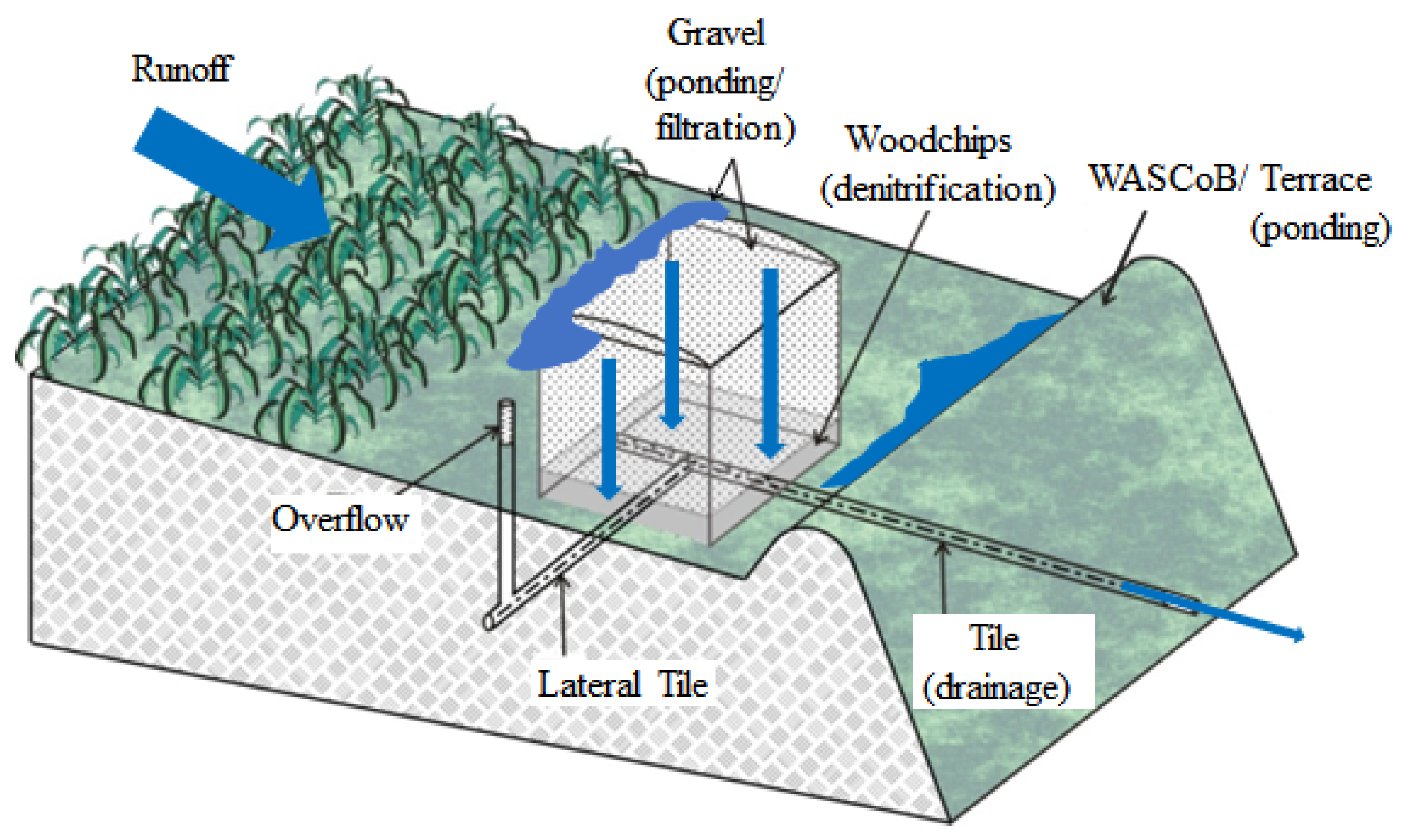
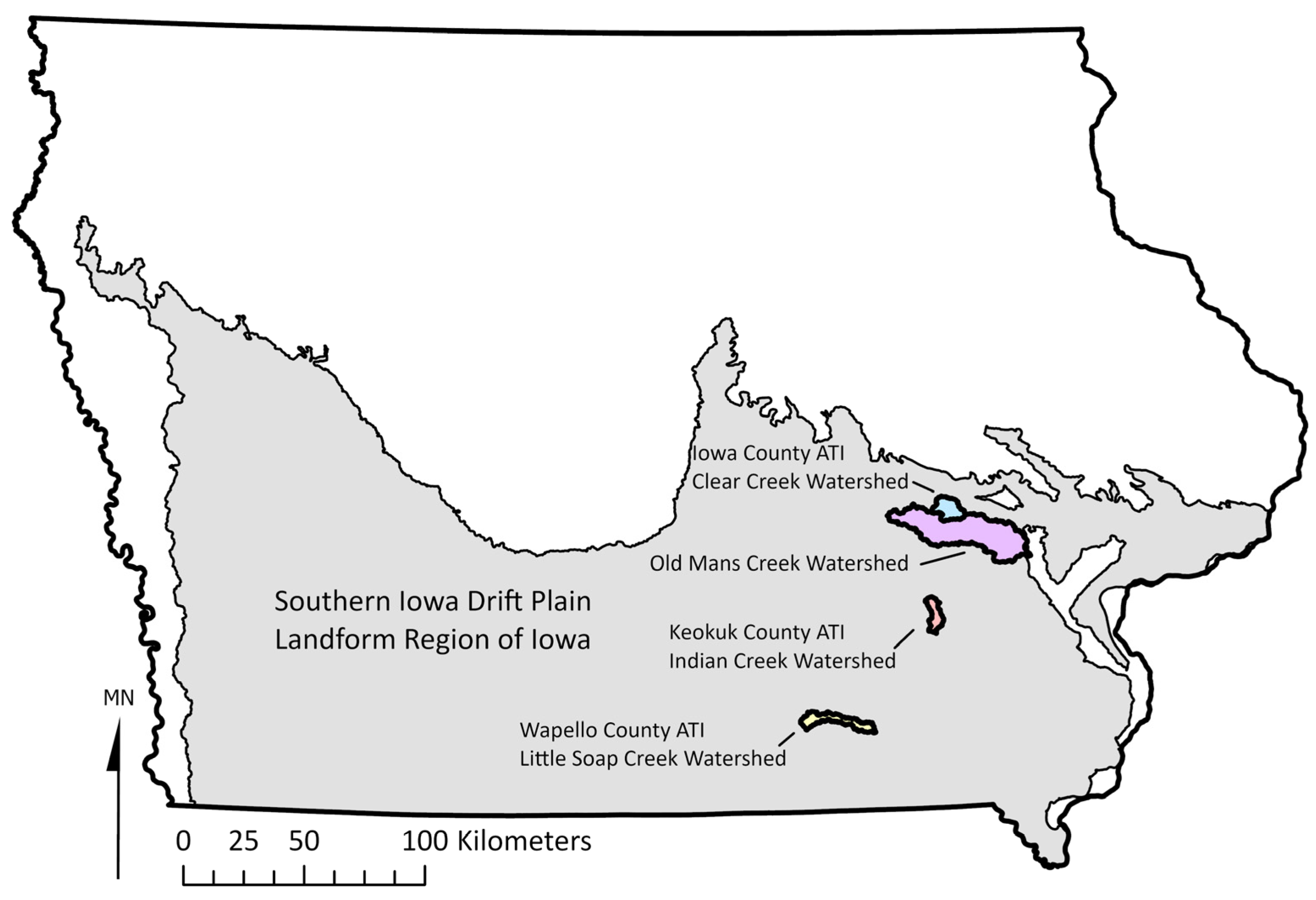
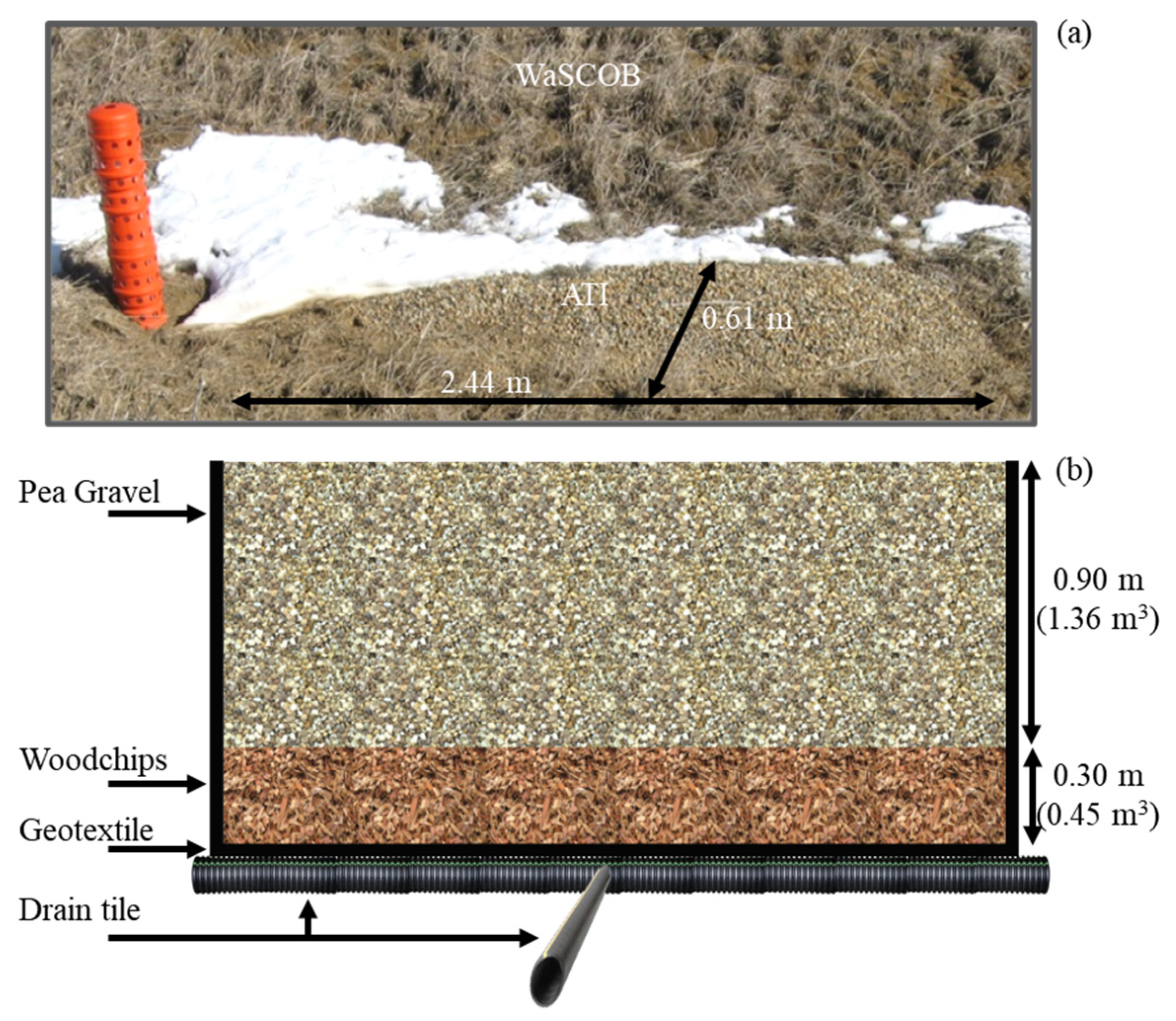
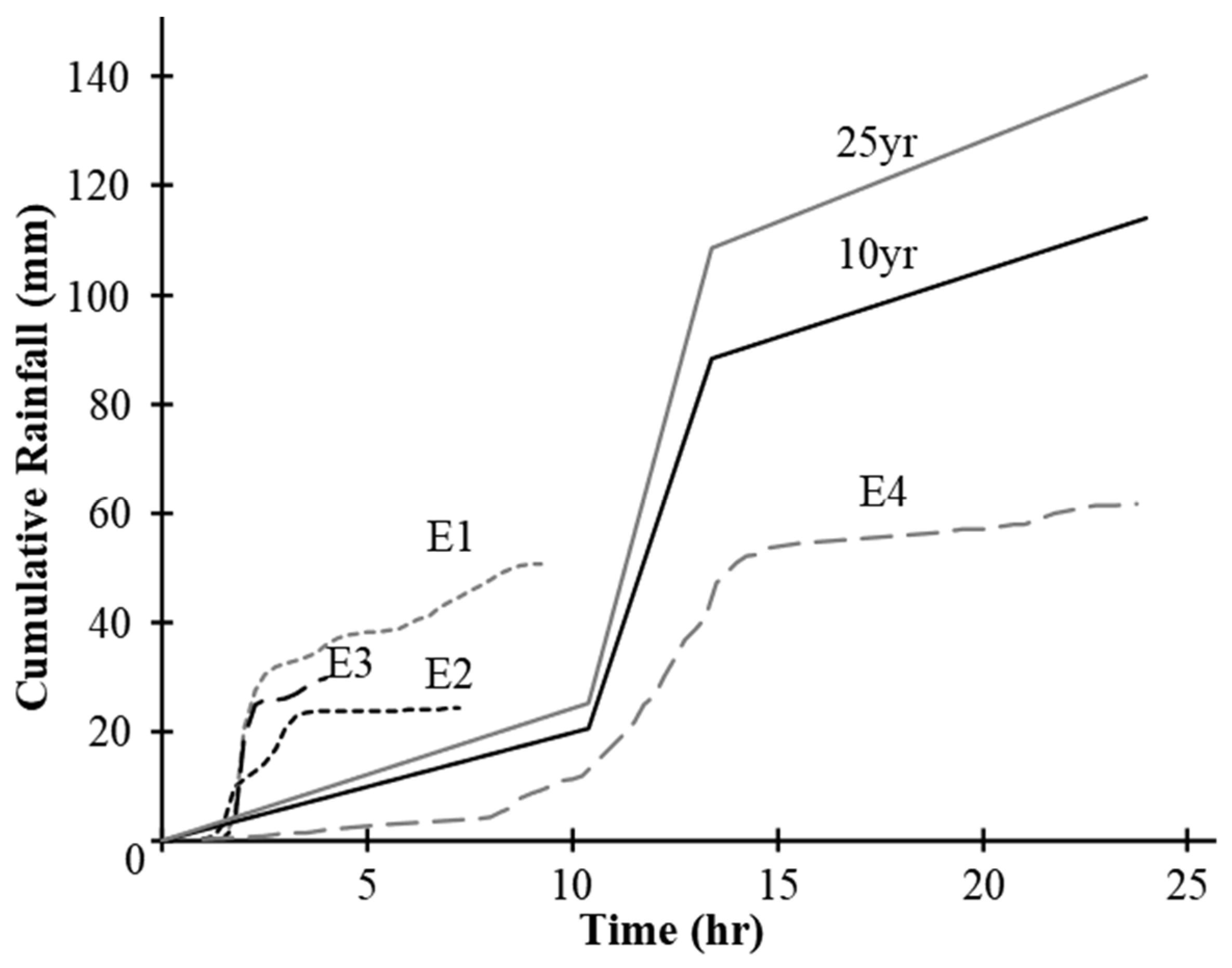
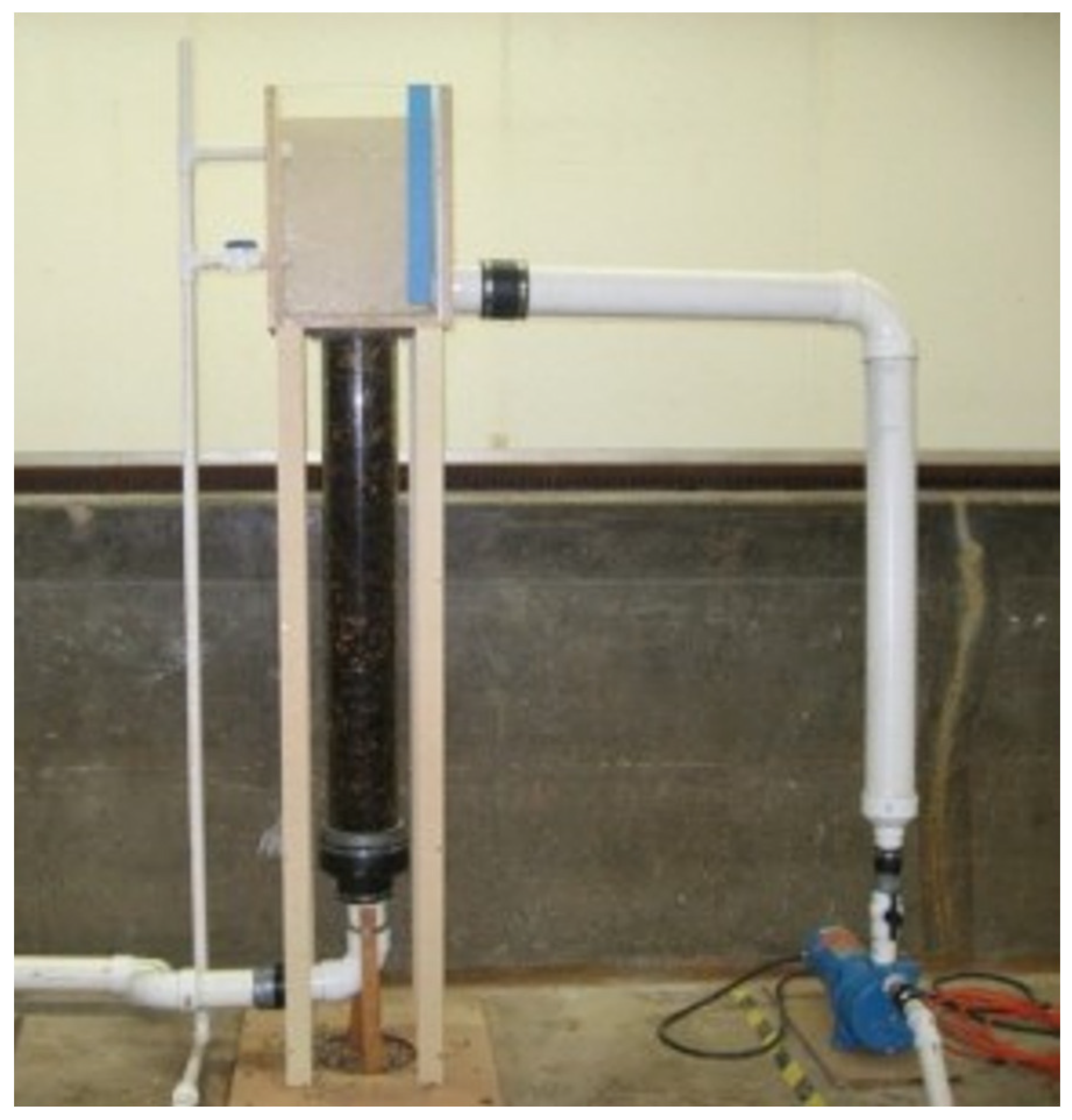

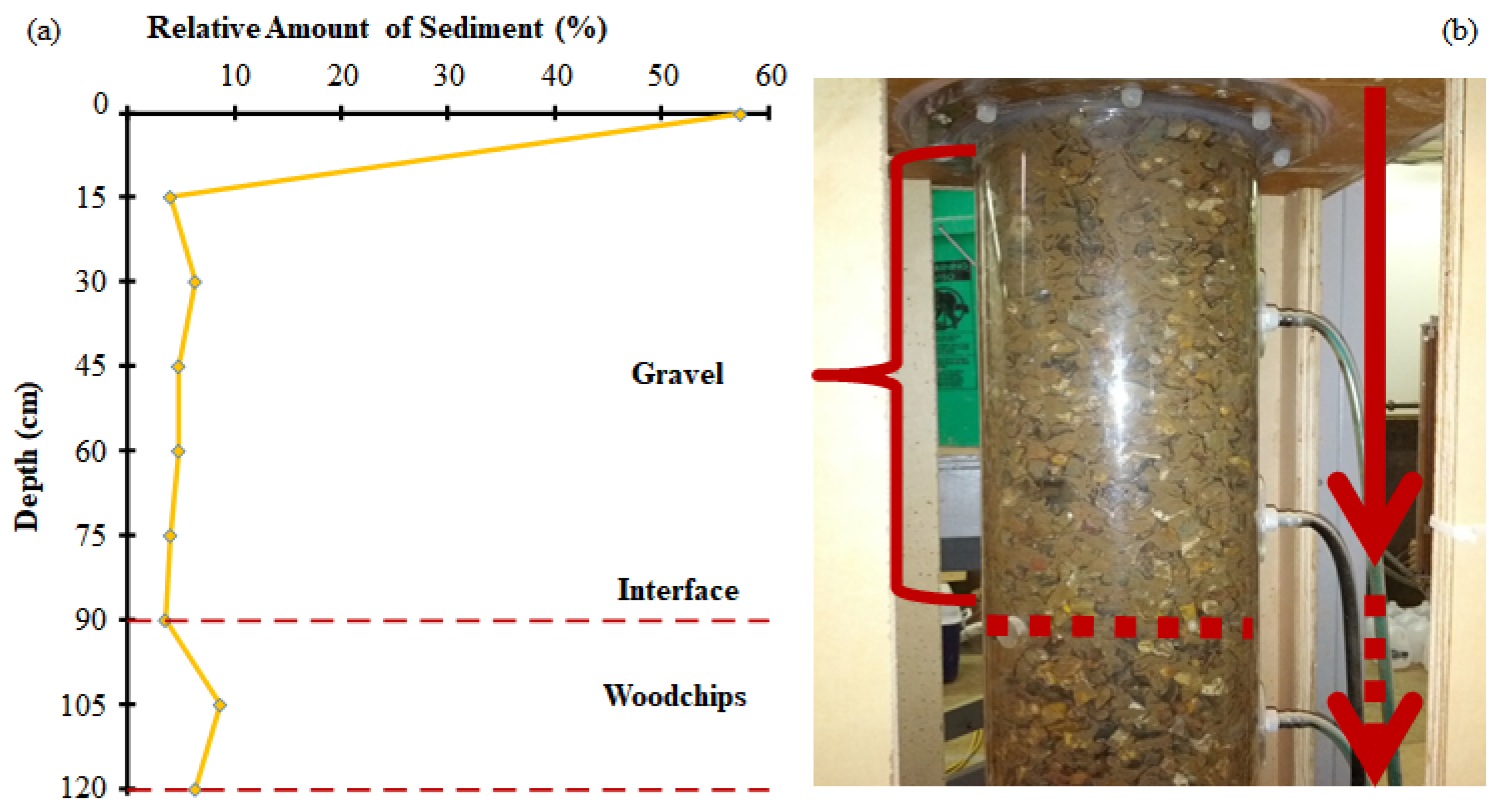
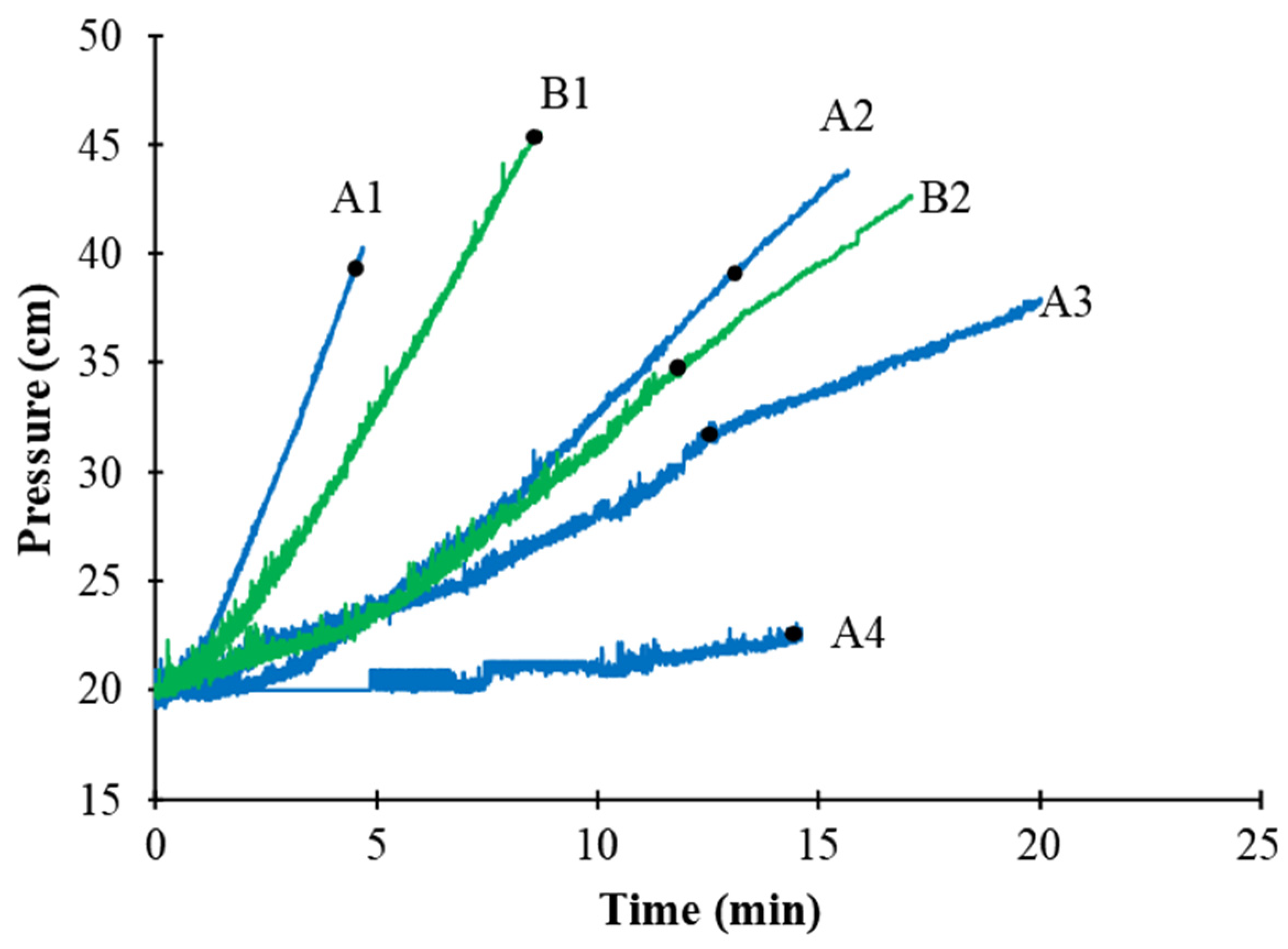
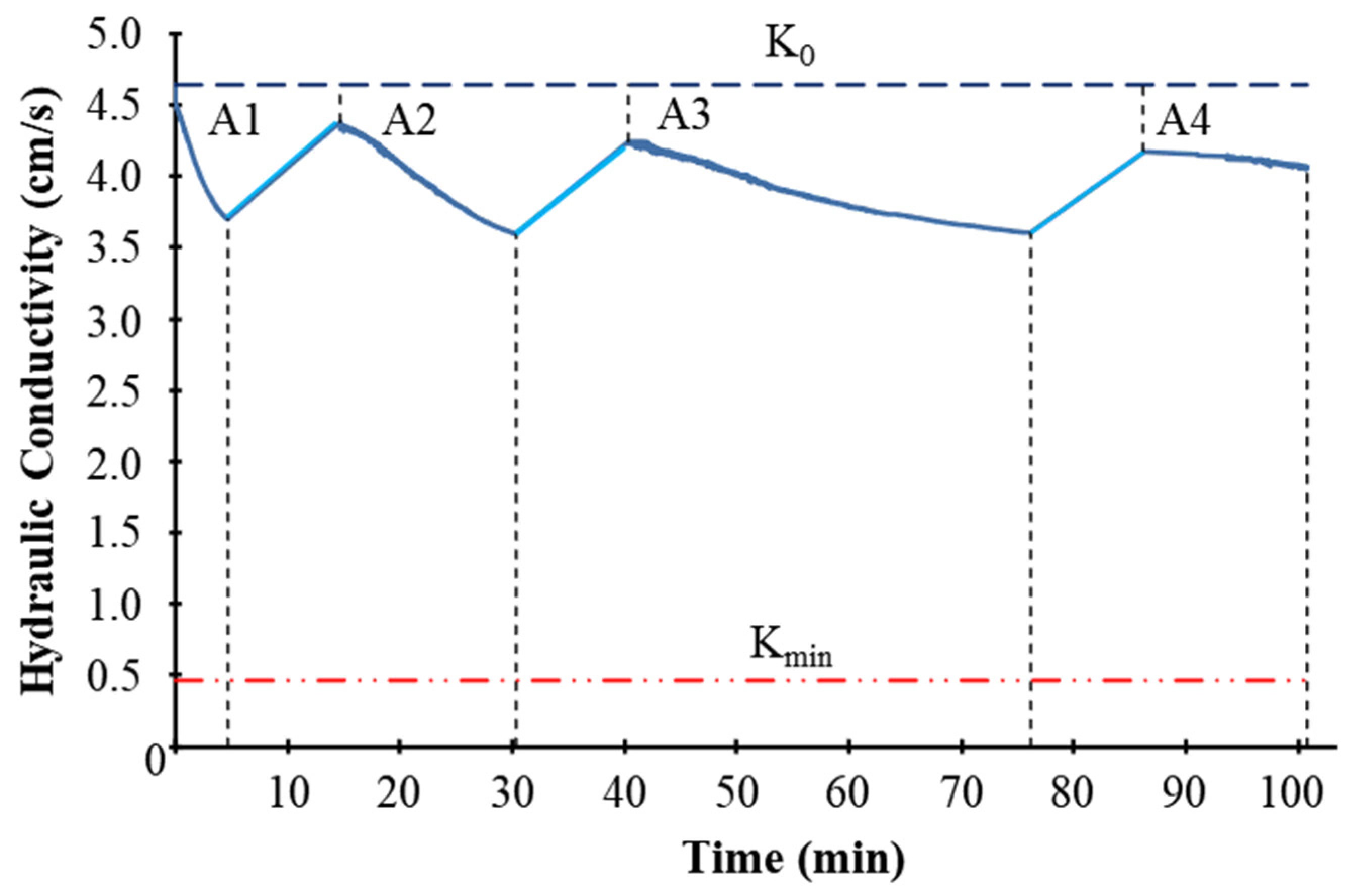
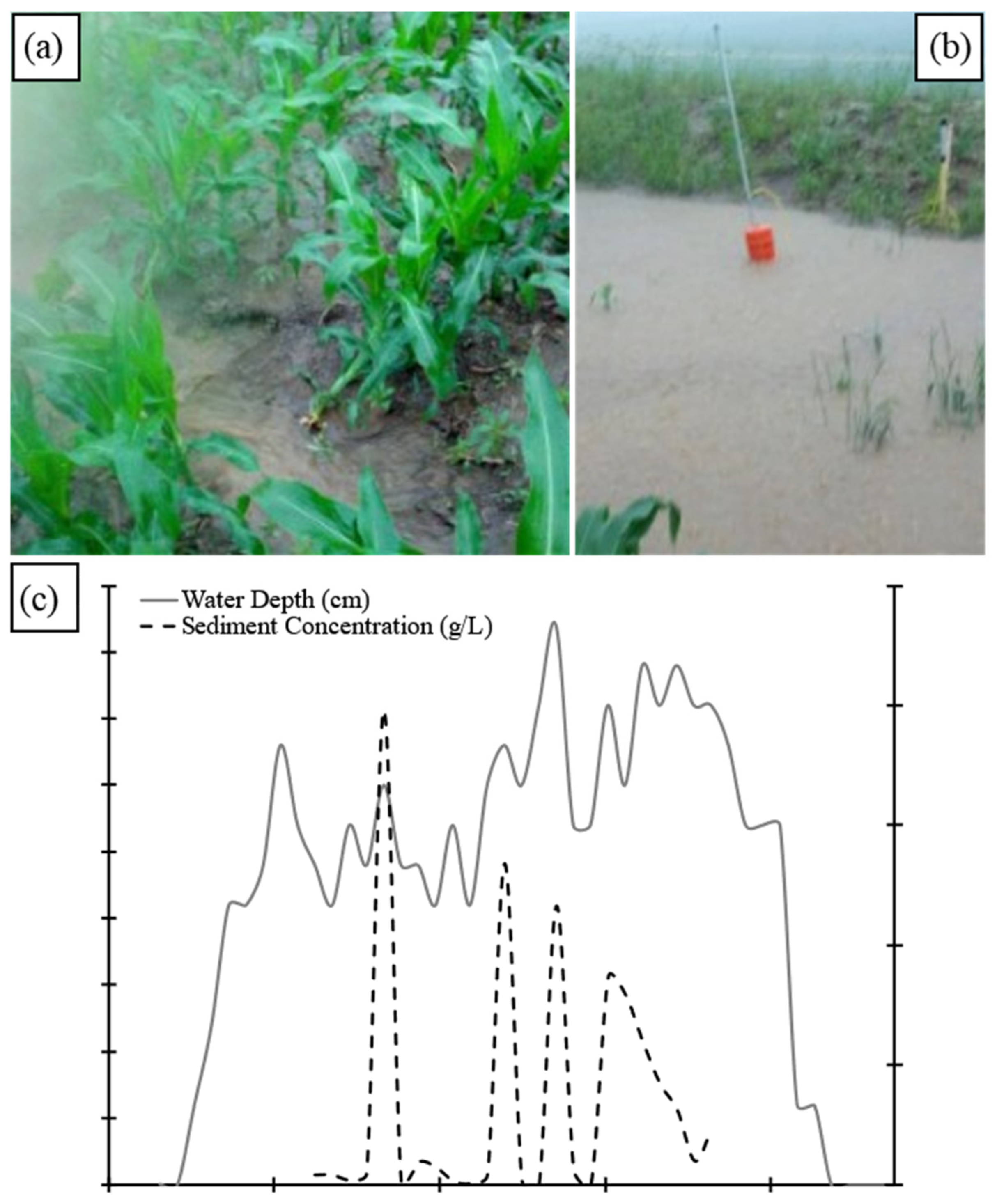

| Parameter | Range of Values |
|---|---|
| Days since last harvest (d) | 280–347 |
| Days since last tillage (d) | 68–135 |
| Cumulative rainfall since last tillage (mm) | 561–1108 |
| Bulk density after last tillage (g/cm3) | 1.30–1.35 |
| Initial canopy cover (0–100%) | 8–98 |
| Initial dead root mass (kg/m2) | 0.025–0.131 |
| Initial submerged residue (kg/m2) | 0.096–0.307 |
| Initial interrill cover (0–100%) | 4.33–59.9 |
| Initial rill cover (0–100%) | 4.33–59.9 |
| Data Source | No. of Simulated Events | Runoff Depth (cm) | Ponding Depth (cm) | Sediment Concentration (g/L) |
|---|---|---|---|---|
| Measured | 140 | 1.9 | 0 | 11.5 (0.3–50.8) |
| Design storm | 40 | 5.8 | 17.5 (14.4–20.7) | 17.0 (4.1–50.5) |
| n | NO3 (mg/L) | TP (mg/L) | OP (mg/L) | ||
|---|---|---|---|---|---|
| 2019 | Surface Runoff | 132 | 16.4 ± 14.9 | - | - |
| Exit Tile | 126 | 8.8 ± 8.2 | - | - | |
| 2021 | Surface Runoff | 136 | 45.2 ± 12.7 | 2.4 ± 0.3 | 1.8 ± 0.2 |
| Exit Tile | 135 | 25.8 ± 12.0 | 2.0 ± 0.2 | 1.6 ± 0.2 |
| Site | Drainage Area (ha) | Drain Time (d): 24 h 25 yr Event | Drain Time (d): 24 h 50 yr Event | Drain Time (d): 24 h 100 yr Event |
|---|---|---|---|---|
| Iowa | 0.24 | 0.2 | 0.2 | 0.3 |
| Keokuk | 0.65 | 0.7 | 0.8 | 0.9 |
| Wapello | 1.4 | 0.9 | 1.0 | 1.1 |
| Parameter | Iowa | Keokuk | Wapello |
|---|---|---|---|
| Runoff Volume (m3/ha/yr) | 2515 | 1930 | 1995 |
| Runoff Coefficient | 0.27 | 0.21 | 0.22 |
| Gross Erosion (T/ha/yr) | 56.2 | 5.4 | 16.1 |
| Net Erosion (T/ha/yr) | 19.8 | 4.8 | 12.0 |
| Exported Erosion (T/ha/yr) | 0.3 | 0.6 | 3.2 |
| Sediment Delivery Ratio | 0.005 | 0.114 | 0.169 |
| Sediment Trapping Efficiency | 98% | 87% | 73% |
| NO3-N | TP | OP | ||
|---|---|---|---|---|
| Load Reduction Rates | kg/ha | 3.45 | 0.05 | 0.02 |
| Total LR Keokuk ATI | kg | 2.2 | 0.03 | 0.01 |
| Total LR Wapello ATI | kg | 4.8 | 0.07 | 0.03 |
| Total LR Clear Creek, Keokuk | kg | 4548 | 64 | 31 |
| Total LR Soap Creek, Wapello | kg | 2279 | 15 | 32 |
| Total LR Old Man’s Creek | kg | 14,856 | 2027 | - |
| Old Man’s Creek Reduction | % | 1.6 | 1.4 | - |
Disclaimer/Publisher’s Note: The statements, opinions and data contained in all publications are solely those of the individual author(s) and contributor(s) and not of MDPI and/or the editor(s). MDPI and/or the editor(s) disclaim responsibility for any injury to people or property resulting from any ideas, methods, instructions or products referred to in the content. |
© 2024 by the authors. Licensee MDPI, Basel, Switzerland. This article is an open access article distributed under the terms and conditions of the Creative Commons Attribution (CC BY) license (https://creativecommons.org/licenses/by/4.0/).
Share and Cite
Wilson, C.G.; Streeter, M.T.; Ettema, W.D.; Abban, B.K.B.; Gonzalez, A.; Schilling, K.E.; Papanicolaou, A.N. Assessing the Effectiveness of Alternative Tile Intakes on Agricultural Hillslopes. Water 2024, 16, 309. https://doi.org/10.3390/w16020309
Wilson CG, Streeter MT, Ettema WD, Abban BKB, Gonzalez A, Schilling KE, Papanicolaou AN. Assessing the Effectiveness of Alternative Tile Intakes on Agricultural Hillslopes. Water. 2024; 16(2):309. https://doi.org/10.3390/w16020309
Chicago/Turabian StyleWilson, Christopher G., Matthew T. Streeter, William D. Ettema, Benjamin K. B. Abban, Adrian Gonzalez, Keith E. Schilling, and Athanasios N. Papanicolaou. 2024. "Assessing the Effectiveness of Alternative Tile Intakes on Agricultural Hillslopes" Water 16, no. 2: 309. https://doi.org/10.3390/w16020309
APA StyleWilson, C. G., Streeter, M. T., Ettema, W. D., Abban, B. K. B., Gonzalez, A., Schilling, K. E., & Papanicolaou, A. N. (2024). Assessing the Effectiveness of Alternative Tile Intakes on Agricultural Hillslopes. Water, 16(2), 309. https://doi.org/10.3390/w16020309







